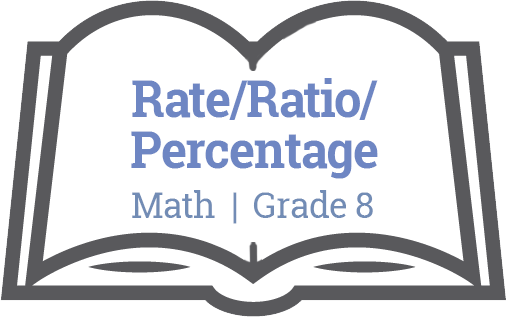
Unit Plan: Rate/Ratio/Percentage
Math / Grade 8

Big Ideas
Number represents, describes, and compares the quantities of ratios, rates, and percents.
Concepts:
- Ratios
- Rates
- Percents
Essential Questions
Students will keep considering…
- What is the best way to represent a quantity?
- What is the role of reasoning when making decisions?
Evaluative Criteria
Teacher Evaluative Criteria:
N/A
Monitoring Progress
N/A
Resources
BOOKS
- Mathlinks8 Textbook or other Math 8 Resource
- Beyond Monet by Barry Bennett
Reflection
How will teachers and their students reflect on and evaluate the completed project?
Teacher:
Next time I teach this unit I would…
Allow students to select the short stories that link to Identity.
Student:
My students needed:
Process:
Product:
Content:
Potential Student Misunderstanding:
Notes throughout lessons.
Downloads
Stage 2 – Evidence
Authentic Performance Tasks
AUTHENTIC PERFORMANCE TASK: Assessing for Understanding
Students will be able to demonstrate their understanding by:
GRASPS
What is a GRASPS task?
Other Evidence
OTHER EVIDENCE: Assessing for Knowledge and Skills
Students will show they have acquired Stage 1 knowledge and skills by:
Assessment: This question allows students to make decisions that will impact safety of the event. Students should be able to organize their data in a table so it can be used and understood. Students should be able to justify their decisions. Students should be able to apply the correct ratio to the correct space and calculate capacity correctly. Students should start to understand that math is a decision making tool in the ‘real world’ and calculation accuracy is required.
Students will be able to calculate the floor area of a room. Students may need to learn estimation skills to measure, or if floor plans are available, students can learn how to read blue prints and calculate scale measurements.
Students can apply the appropriate factor to calculate the maximum number of people per area.
Students can organize their data in a table and justifiy their calculations.
Students can apply percentage calculations to consider what happens if the room is over populated.

The following resources are made available through the British Columbia Ministry of Education. For more information, please visit BC’s New Curriculum.
Big Ideas
The Big Ideas consist of generalizations and principles and the key concepts important in an area of learning. The Big Ideas represent what students will understand at the completion of the curriculum for their grade. They are intended to endure beyond a single grade and contribute to future understanding.
Core Competencies
 Communications Competency
Communications Competency
The set of abilities that students use to impart and exchange information, experiences and ideas, to explore the world around them, and to understand and effectively engage in the use of digital media
 Thinking Competency
Thinking Competency
The knowledge, skills and processes we associate with intellectual development
 Social Competency
Social Competency
The set of abilities that relate to students’ identity in the world, both as individuals and as members of their community and society
Curricular Competencies & Content
Curricular Competencies are the skills, strategies, and processes that students develop over time. They reflect the “Do” in the Know-Do-Understand model of curriculum. The Curricular Competencies are built on the thinking, communicating, and personal and social competencies relevant to disciplines that make up an area of learning.
Additional Resources
First People's Principles of Learning
To read more about First People’s Principles of Learning, please click here.
For classroom resources, please visit the First Nations Education Steering Committee.
